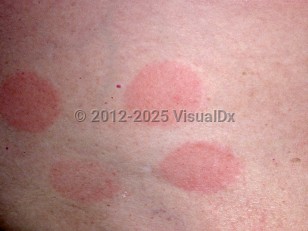Allergic contact dermatitis - Hair and Scalp
See also in: Overview,Cellulitis DDx,External and Internal Eye,Anogenital,Nail and Distal Digit,Oral Mucosal LesionAlerts and Notices
Important News & Links
Synopsis

Allergic contact dermatitis (ACD) is a delayed-type (type IV) hypersensitivity reaction that occurs when allergens activate antigen-specific T cells in a sensitized individual. It typically requires repeated exposures before an allergic response is noted and most commonly occurs 24-48 hours after exposure to the offending agent.
ACD generally presents with well-demarcated borders, suggestive of an "outside job" or external contact. Causative allergens and their clinical importance vary based on several factors, including certain geographic regions, cultural practices, personal care product usage, and manufacturing practices (ie, which preservatives are used). Common contact allergens are urushiol (poison ivy, oak, and sumac), nickel, fragrance, cobalt, chromates (leather products), neomycin, thimerosal (ophthalmic preparations and vaccines), adhesives, and oxybenzone (sunscreens).
ACD can also present as a systemic contact reaction with widespread lesions when the offending agent is ingested, present in an implanted device, or used in a manner that covers a large portion of the body (eg, body washes). ACD can occur in reaction to topical or ingested agents, implanted biomedical devices, and airborne materials.
Codes
L23.9 – Allergic contact dermatitis, unspecified cause
SNOMEDCT:
40275004 – Contact dermatitis
Look For
Subscription Required
Diagnostic Pearls
Subscription Required
Differential Diagnosis & Pitfalls

Subscription Required
Best Tests
Subscription Required
Management Pearls
Subscription Required
Therapy
Subscription Required
Drug Reaction Data
Subscription Required
References
Subscription Required
Last Updated:10/09/2024
 Patient Information for Allergic contact dermatitis - Hair and Scalp
Patient Information for Allergic contact dermatitis - Hair and Scalp- Improve treatment compliance
- Reduce after-hours questions
- Increase patient engagement and satisfaction
- Written in clear, easy-to-understand language. No confusing jargon.
- Available in English and Spanish
- Print out or email directly to your patient


